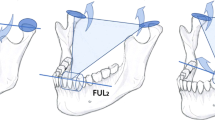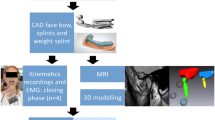Abstract
The changes in the minimum time to consciously react (reaction time) and the order of jaw muscle recruitment to precisely controlled axial stimulation of the incisors during controlled jaw movements are not known. To this end, ten subjects were recruited to investigate the reaction time of bilateral temporalis and masseter muscles and bite force. Stimuli were delivered axially to the upper central incisors during active jaw closing and opening, and under static conditions. The results showed that the reaction time was increased an average of 35% during both jaw opening and closing movements when compared with static jaw conditions. The left temporalis was recruited approximately 10 ms before the right temporalis, whereas no significant side differences were found between the masseter muscles. The masseter muscles were recruited an average of 20 ms before the temporalis muscles during jaw closing, but no difference existed during opening. Under static conditions the reaction time in the bite force was approximately 16 ms longer than the left temporalis, but was not significantly different from the reaction time of any of the other muscles, indicating that, under the static conditions tested, the left temporalis was more often responsible for initiation of the mechanical reactions in the jaw. Because of active compensation, no force measurements were made during jaw movement. This study is a prerequisite for investigations into the modulation of reflexes during jaw movement, because a response to a stimulus commencing after the minimum reaction time may not be entirely reflex in origin.







Similar content being viewed by others
References
Andreatta RD, Barlow SM (2003) Movement-related modulation of vibrotactile detection thresholds in the human orofacial system. Exp Brain Res 149:75–82
Blair-Thomas CA, Luschei ES (1975) Increases in reflex excitability of monkey masseter motoneurons before a jaw-bite reaction-time response. J Neurophysiol 38:981–989
Blanksma NG, van Eijden TM (1990) Electromyographic heterogeneity in the human temporalis muscle. J Dent Res 69:1686–1690
Blanksma NG, van Eijden TM (1995) Electromyographic heterogeneity in the human temporalis and masseter muscles during static biting, open/close excursions, and chewing. J Dent Res 74:1318–1327
Blanksma NG, van Eijden TM, Weijs WA (1992) Electromyographic heterogeneity in the human masseter muscle. J Dent Res 71:47–52
Brinkworth RSA (2004) A Lab View®-based software application for recording and analysis of human movement experiment, chap 13. In: response of the human jaw to mechanical stimulation of teeth. Thesis, School of Molecular and Biomedical Science, The University of Adelaide, pp 211–257. http://thesis.library.adelaide.edu.au/public/adt-SUA20050110.160608/
Brinkworth RSA, Türker KS (2003) A method for quantifying reflex responses from intra-muscular and surface electromyogram. J Neurosci Methods 122:179–193
Brinkworth RSA, Türker KS (2004) Reaction time of human jaw under static and dynamic conditions. In: Proceedings of the Australian Neuroscience Society, vol 15. Australian Neuroscience Society, Melbourne
Brinkworth RSA, Türker KS (2005) EMG, force and discharge rate analysis of human jaw reflexes in response to axial stimulation of the incisor. Exp Brain Res 161:145–154
Brinkworth RSA, Türker KS, Savundra AW (2003) Response of human jaw muscles to axial stimulation of the incisor. J Physiol 547:233–245
Brinkworth RSA, Male C, Türker KS (2004a) Response of human jaw to axial stimulation of a molar tooth. Exp Brain Res 159:214–224
Brinkworth RSA, Whitham E, Nazeran H (2004b) Establishment of paediatric biochemical reference intervals. Ann Clin Chem 41:321–329
Brodin P, Miles TS, Türker KS (1993a) Simple reaction-time responses to mechanical and electrical stimuli in human masseter muscle. Arch Oral Biol 38:221–226
Brodin P, Türker KS, Miles TS (1993b) Mechanoreceptors around the tooth evoke inhibitory and excitatory reflexes in the human masseter muscle. J Physiol 464:711–723
Brooke JD, Peritore G, Staines WR, McIlroy WE, Nelson A (2000) Upper limb H reflexes and somatosensory evoked potentials modulated by movement. J Electromyogr Kinesiol 10:211–215
Burke D, Adams RW, Skuse NF (1989) The effect of voluntary contraction on the H reflex of human limb muscles. Brain 112:417–433
Butler SL, Miles TS, Thompson PD, Nordstrom MA (2001) Task-dependent control of human masseter muscles from ipsilateral and contralateral motor cortex. Exp Brain Res 137:65–70
Cathers I, O’Dwyer N, Neilson P (2004) Variation of magnitude and timing of wrist flexor stretch reflex across the full range of voluntary activation. Exp Brain Res 157:324–335
Chandler SH, Nielsen SA, Goldberg LJ (1985) The effects of a glycine antagonist (strychnine) on cortically induced rhythmical jaw movements in the anesthetized guinea pig. Brain Res 325:181–186
Chapman CE, Bushnell MC, Miron D, Duncan GH, Lund JP (1987) Sensory perception during movement in man. Exp Brain Res 68:516–524
Cruccu G (1986) Intracranial stimulation of the trigeminal nerve in man. I. Direct motor responses. J Neurol Neurosurg Psychiatry 49:411–418
De Luca CJ, LeFever RS, McCue MP, Xenakis AP (1982) Behaviour of human motor units in different muscles during linearly varying contractions. J Physiol 329:113–128
Delcomyn F (1980) Neural basis of rhythmic behavior in animals. Science 210:492–498
Dellow PG, Lund JP (1971) Evidence for central timing of rhythmical mastication. J Physiol 215:1–13
Desmedt JE, Godaux E (1979) Recruitment patterns of single motor units in the human masseter muscle during brisk jaw clenching. Arch Oral Biol 24:171–178
van Eijden TM, Brugman P, Weijs WA, Oosting J (1990) Coactivation of jaw muscles: recruitment order and level as a function of bite force direction and magnitude. J Biomech 23:475–485
Ervilha UF, Arendt-Nielsen L, Duarte M, Graven-Nielsen T (2004) Effect of load level and muscle pain intensity on the motor control of elbow-flexion movements. Eur J Appl Physiol 91:168–175
Fukuyama E, Fujita Y, Soma K (2000) Changes in jaw-jerk on different levels of jaw closure and teeth-clenching in humans. J Oral Rehabil 27:967–977
van der Glas HW, Weytjens JL, De Laat A, van Steenberghe D, Pardaens JL (1984) The influence of clenching level on the post-stimulus EMG complex, including silent period of the masseter muscles in man. Arch Oral Biol 29:54–58
van der Glas HW, De Laat A, van Steenberghe D (1985) Oral pressure receptors mediate a series of inhibitory and excitatory periods in the masseteric poststimulus EMG complex following tapping of a tooth in man. Brain Res 337:117–125
Godaux E, Desmedt JE (1975) Human masseter muscle: H- and tendon reflexes. Arch Neurol 32:229–234
Hannam AG, Matthews B (1968) Reflex jaw opening as a result of mechanical stimulation of the teeth. J Physiol 198:116–117
Hoogmartens M (1986) Left-right ratio of the stretch reflex amplitude in the human masseter muscles: a methodological approach. In: Electromyography and clinical neurophysiology. Katholieke, Leuven, p 144
Kemppainen P, Leppanen H, Waltimo A, Pertovaara A (1993) Effects of jaw clenching, jaw movement and static jaw position on facial skin sensitivity to non-painful electrical stimulation in man. Arch Oral Biol 38:303–308
Kemppainen P, Vaalamo I, Leppala N, Pertovaara A (2001) Changes in tooth pulpal detection and pain thresholds in relation to jaw movement in man. Arch Oral Biol 46:33–37
Lamarre Y, Lund JP (1975) Load compensation in human masseter muscles. J Physiol 253:21–35
Lin LD, Murray GM, Sessle BJ (1993) The effect of bilateral cold block of the primate face primary somatosensory cortex on the performance of trained tongue- protrusion task and biting tasks. J Neurophysiol 70:985–996
Louca C, Cadden SW, Linden RWA (1994) Inhibitory jaw reflexes and the role played by periodontal ligament mechanoreceptors. J Dent Res 73:791–791
Lund JP (1991) Mastication and its control by the brain stem. Crit Rev Oral Biol Med 2:33–64
Luschei ES, Goodwin GM (1975) Role of monkey precentral cortex in control of voluntary jaw movements. J Neurophysiol 38:146–157
Matthews PB (1986) Observations on the automatic compensation of reflex gain on varying the pre-existing level of motor discharge in man. J Physiol 374:73–90
McMillan S, Nougier V, Byblow WD (2004) Human corticospinal excitability during a precued reaction time paradigm. Exp Brain Res 156:80–87
McNamara DC, Crane PF, McCall JWD, Ash JMM (1977) Duration of the electromyographic silent period following the jaw-jerk reflex in human subjects. J Dent Res 56:660–664
Miles TS, Türker KS (1986) Does reflex inhibition of motor units follow the “size principle”? Exp Brain Res 62:443–445
Møller E (1966) The chewing apparatus. An electromyographic study of the action of the muscles of mastication and its correlation to facial morphology. Acta Physiol Scand Suppl 280:1–229
Murray GM, Klineberg IJ (1984) Electromyographic recordings of human jaw-jerk reflex characteristics evoked under standardized conditions. Arch Oral Biol 29:537–549
Nielsen I, Miller AJ (1988) Response patterns of craniomandibular muscles with and without alterations in sensory feedback. J Prosthet Dent 59:352–362
Nozaki S, Iriki A, Nakamura Y (1986) Localization of central rhythm generator involved in cortically induced rhythmical masticatory jaw-opening movement in the guinea pig. J Neurophysiol 55:806–825
Ottenhoff FA, van der Bilt A, van der Glas HW, Bosman F (1992) Peripherally induced and anticipating elevator muscle activity during simulated chewing in humans. J Neurophysiol 67:75–83
Poliakov AV, Miles TS (1994) Stretch reflexes in human masseter. J Physiol 476:323–331
Riedo R, Ruegg DG (1988) Origin of the specific H reflex facilitation preceding a voluntary movement in man. J Physiol 397:371–388
Schmidt RF, Schady WJ, Torebjork HE (1990) Gating of tactile input from the hand. I. Effects of finger movement. Exp Brain Res 79:97–102
Scutter SD, Türker KS (1998) Recruitment stability in masseter motor units during isometric voluntary contractions. Muscle Nerve 21:1290–1298
Scutter SD, Türker KS (2000) Estimating relative motoneurone size in human masseter muscle. Arch Oral Biol 45:617–620
Sessle BJ, Schmitt A (1972) Effects of controlled tooth stimulation of jaw muscle activity in man. Arch Oral Biol 17:1597–1607
Smith A, Moore CA, Weber CM, McFarland DH, Jerald MB (1985) Reflex responses of the human jaw-closing system depend on the locus of intraoral mechanical stimulation. Exp Neurol 90:489–509
Toft E, Sinkjaer T, Andreassen S (1989) Mechanical and electromyographic responses to stretch of the human anterior tibial muscle at different levels of contraction. Exp Brain Res 74:213–219
Türker KS (1988) A method for standardization of silent period measurements in human masseter muscle. J Oral Rehabil 15:91–101
Türker KS, Jenkins M (2000) Reflex responses induced by tooth unloading. J Neurophysiol 84:1088–1092
Türker KS, Yang J, Brodin P (1997) Conditions for excitatory or inhibitory masseteric reflexes elicited by tooth pressure in man. Arch Oral Biol 42:121–128
Türker KS, Brinkworth RSA, Abolfathi PP, Linke IR, Nazeran H (2004) A device for investigating the neuromuscular control of the human masticatory system. J Neurosci Meth 136:141–149
Warwick R, Williams PL (eds) (1973) Gray’s anatomy. Longman, London
Welford AT (1988) Reaction time, speed of performance, and age. Ann N Y Acad Sci 515:1–17
Westberg KG, Kolta A, Clavelou P, Sandstrom G, Lund JP (2000) Evidence for functional compartmentalization of trigeminal muscle spindle afferents during fictive mastication in the rabbit. Eur J Neurosci 12:1145–1154
Wolpaw JR, Carp JS (1990) Memory traces in spinal cord. Trends Neurosci 13:137–142
Xu JC (1996) Multiple comparisons: theory and methods. Chapman and Hall, London
Yamada Y, Stohler CS, Shimada K, Ash JMM (1985) Short and long latency jaw-opening reflex responses elicited by mechanical stimulation in man. Arch Oral Biol 30:197–200
Yao D, Yamamura K, Narita N, Murray GM, Sessle BJ (2002) Effects of reversible cold block of face primary somatosensory cortex on orofacial movements and related face primary motor cortex neuronal activity. Somatosens Mot Res 19:261–271
Ziemann U, Tergau F, Netz J, Homberg V (1997) Delay in simple reaction time after focal transcranial magnetic stimulation of the human brain occurs at the final motor output stage. Brain Res 744:32–40
Acknowledgements
Special thanks to Mr Andreas Kiermeier from Biometrics SA for his invaluable statistical expertise. This study was supported by the National Health and Medical Research Council (NH&MRC) of Australia. R.S.A.B was the recipient of an Australian Postgraduate Award.
Author information
Authors and Affiliations
Corresponding author
Rights and permissions
About this article
Cite this article
Brinkworth, R.S.A., Türker, K.S. Jaw movement alters the reaction of human jaw muscles to incisor stimulation. Exp Brain Res 164, 165–176 (2005). https://doi.org/10.1007/s00221-005-2239-4
Received:
Accepted:
Published:
Issue Date:
DOI: https://doi.org/10.1007/s00221-005-2239-4




